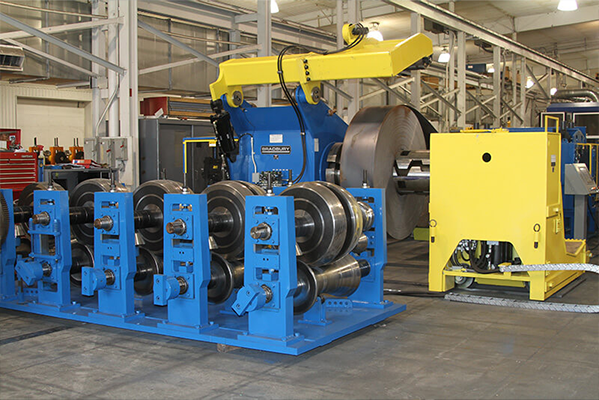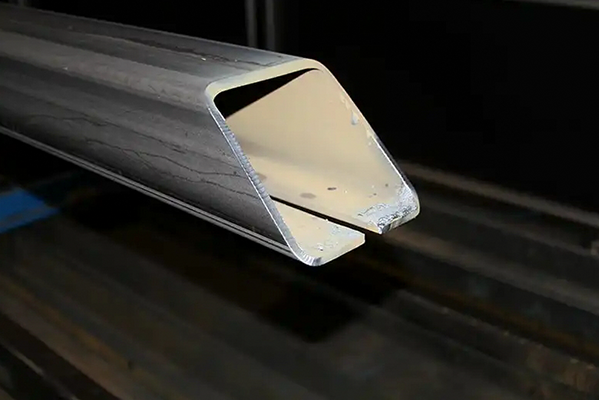Navigation Menu
Contact Us
- Email:
- info@wxavatar.com
- Address:
- Yurong Village, Yuqi Street, Huishan District, Wuxi, China.
Release Date:Mar 31, 2025 Visit:56 Source:Roll Forming Machine Factory
In modern manufacturing, the demand for high-strength, durable, and complex metal components continues to grow across industries such as construction, automotive, aerospace, and energy. To meet these needs, heavy gauge roll forming lines have emerged as a cornerstone technology for producing large-scale, high-precision metal profiles. This article explores the fundamentals, components, applications, and advantages of heavy gauge roll forming lines, shedding light on their critical role in industrial production.
What Is a Heavy Gauge Roll Forming Line?
A heavy gauge roll forming line is an automated manufacturing system designed to shape thick metal sheets or coils (typically ranging from 3 mm to over 20 mm in thickness) into continuous, uniform profiles with complex cross-sectional geometries. Unlike conventional stamping or extrusion methods, roll forming employs a series of progressively arranged rollers to gradually bend the metal into the desired shape. This process is ideal for producing long, high-strength components such as beams, channels, brackets, and structural supports.
The term "heavy gauge" refers to the system’s capability to handle thicker and stronger materials, including high-tensile steel, aluminum alloys, and stainless steel, which are commonly used in load-bearing applications.
Key Components of a Heavy Gauge Roll Forming Line
1.Uncoiler/Decoiler
Feeds the metal coil into the system. Heavy-duty uncoilers are designed to handle large, heavy coils (up to several tons) and maintain consistent tension.
2.Leveling/Straightening Unit
Removes any residual curvature or defects from the metal coil to ensure flatness before forming.
3.Roll Forming Stations
A series of roller dies arranged in sequence, each performing incremental bends to shape the metal. Heavy gauge systems use hardened steel rollers with high wear resistance to withstand the stress of forming thick materials.

4.Cutting System
A flying cutoff saw, hydraulic shear, or laser cutter trims the formed profile to the required length without stopping the production line.
5.Control System
Advanced PLC (Programmable Logic Controller) and HMI (Human-Machine Interface) technologies automate the process, ensuring precision in speed, alignment, and cutting.
6.Post-Processing Units
Optional additions include punching, drilling, embossing, or welding stations for secondary operations.
Applications of Heavy Gauge Roll Forming
Heavy gauge roll forming lines are indispensable in industries requiring robust, high-tolerance components:
Construction: Structural steel beams, roof trusses, and seismic-resistant frameworks.
Transportation: Truck chassis, railcar components, and trailer frames.
Energy: Wind turbine towers, solar panel supports, and pipeline systems.
Mining and Agriculture: Heavy-duty equipment parts and machinery frames.
Advantages Over Traditional Methods
1.High Efficiency
Continuous processing reduces material waste and speeds up production compared to batch-based methods like stamping.
2.Precision and Consistency
Computer-controlled systems ensure tight tolerances (±0.5 mm or better) across long production runs.
3.Material Savings
Minimal scrap generation due to optimized forming sequences.
4.Versatility
Capable of producing multiple profiles by changing roller dies, enabling flexible manufacturing.
5.Strength Retention
Cold-forming preserves the metal’s structural integrity, avoiding weaknesses caused by excessive heat.
Challenges and Innovations
While heavy gauge roll forming offers numerous benefits, challenges include:
High Initial Investment: Advanced systems require significant capital for machinery and tooling.
Maintenance Complexity: Heavy-duty rollers and cutting tools demand regular upkeep.
Material Limitations: Extremely thick or brittle metals may require specialized handling.

Recent innovations address these issues:
Servo-Driven Systems: Improve energy efficiency and precision.
Predictive Maintenance: IoT-enabled sensors monitor equipment health in real time.
Hybrid Lines: Combine roll forming with laser cutting or robotic welding for all-in-one processing.
Future Trends
1.Smart Manufacturing: Integration with AI for adaptive process optimization.
2.Lightweight Materials: Adoption of advanced alloys for applications in electric vehicles and renewable energy.
3.Sustainability: Recycling scrap metal and reducing energy consumption through greener technologies.
Conclusion
Heavy gauge roll forming lines represent a fusion of precision engineering and industrial automation, enabling the cost-effective production of critical metal components for demanding applications. As industries push toward stronger, lighter, and more sustainable solutions, advancements in roll forming technology will continue to play a pivotal role in shaping the future of manufacturing.
By embracing automation, material science breakthroughs, and digitalization, heavy gauge roll forming is poised to remain a cornerstone of modern metal fabrication.